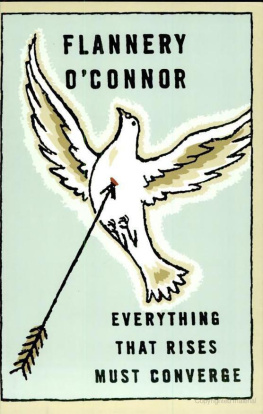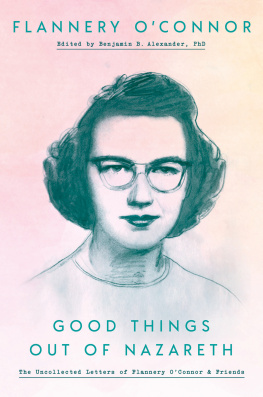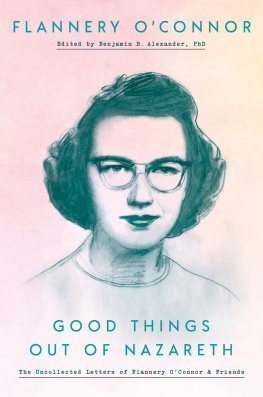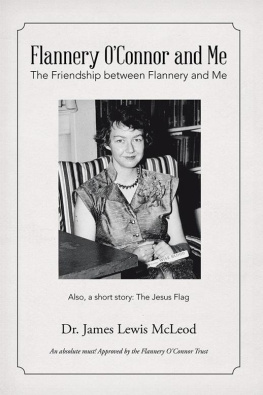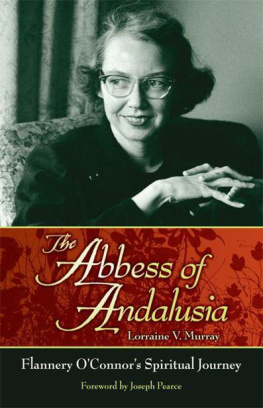Flannery OConnor - Everything That Rises Must Converge
Here you can read online Flannery OConnor - Everything That Rises Must Converge full text of the book (entire story) in english for free. Download pdf and epub, get meaning, cover and reviews about this ebook. year: 1993, publisher: Farrar, Straus and Ciroux, genre: Art. Description of the work, (preface) as well as reviews are available. Best literature library LitArk.com created for fans of good reading and offers a wide selection of genres:
Romance novel
Science fiction
Adventure
Detective
Science
History
Home and family
Prose
Art
Politics
Computer
Non-fiction
Religion
Business
Children
Humor
Choose a favorite category and find really read worthwhile books. Enjoy immersion in the world of imagination, feel the emotions of the characters or learn something new for yourself, make an fascinating discovery.
- Book:Everything That Rises Must Converge
- Author:
- Publisher:Farrar, Straus and Ciroux
- Genre:
- Year:1993
- Rating:3 / 5
- Favourites:Add to favourites
- Your mark:
- 60
- 1
- 2
- 3
- 4
- 5
Everything That Rises Must Converge: summary, description and annotation
We offer to read an annotation, description, summary or preface (depends on what the author of the book "Everything That Rises Must Converge" wrote himself). If you haven't found the necessary information about the book — write in the comments, we will try to find it.
Everything That Rises Must Converge — read online for free the complete book (whole text) full work
Below is the text of the book, divided by pages. System saving the place of the last page read, allows you to conveniently read the book "Everything That Rises Must Converge" online for free, without having to search again every time where you left off. Put a bookmark, and you can go to the page where you finished reading at any time.
Font size:
Interval:
Bookmark:
Everything That Rises Must Converge
by
Flannery O'ConnerNEW YORK
Copyright (c) 1956, 1957, 1958, 1960, 1961, 1962, 1964, 1965 by the Estate of Mary Flannery O'Connor Library of Congress catalog card number 65-13726 All rights reserved Nineteenth printing, 1978 Acknowledgment is made to the editors of the following publications in whose pages some of these stories first appeared: The Kenyon Review, New World Writing, Partisan Review, Esquire, and Harper's Bazaar. Published simultaneously in Canada Manufactured in the United States of America
Introduction
BY ROBERT FITZGERAIJD
I
She was a girl who started with a gift for cartooning and satire, and found in herself a far greater gift, unique in her time and place, a marvel. She kept going deeper (this is a phrase she used) until making up stories became, for her, a way of testing and defining and conveying that superior knowledge that must be called religious. It must be called religious but with no false note in our voices, because her writing will make any false note that is applied to it very clear indeed. Bearing hard upon motives and manners, her stories as moralities cut in every direction and sometimes go to the bone of regional and social truth. But we are not likely to state what they show as well as they show it. We can stay on the safe side by affirming, what is true and usefully borne in mind, that making up stories was her craft, her pleasure and her vocation, that her work from first to last is imaginative writing, often comic writing, superbly achieved and always to be enjoyed as that. We had better let our awareness of the knowledge in her stories grow quietly without forcing it, for nothing could be worse than to treat them straight off as problems for exegesis or texts to preach on.
II
The new severely cut slab of marble bearing her name and the dates March 25, 1925-August 3, 1964 lies in the family plot on a bare elevated place in the Milledgeville cemetery, beside another slab of identical shape marking the grave of her father, but his has also a soldier's headstone for Edward F. O'Connor, Jr., Lt. 325th Infantry, 82nd Division, who died February xst, 1941. I have been out there with her mother to note it all and to say my heart's prayer as I should, though generally I feel as I gather Flannery felt about cemeteries, that they and all they contain are just as well left in God's keeping and that one had better commune with persons, living or dead, than with gravestones and the silent earth. Milledgeville on a mild winter day without leafmess or bloom suggests no less remarkably than in the dogwood season (when I came before) the strict amenity of the older South, or at least this is what I make of there being so many pillared white houses. It was, after all, the capital of Georgia until after the War Between the States.
At the Cline house in town I have been out on the front porch, hatless and coatless in the sun, between the solid handcarved columns, fluted and two stories high, that were hoisted in place when the house was built in 1820 and the slaves, they say, were making by hand the bricks for the house and the openwork walls around the garden. Peter Cline acquired this place in 1886. He was a prominent man, in our American phrase, for many years mayor of the town, and he married successively two sisters, Kate L. and Margaret Ida Treanor. By the former he had seven children and by the latter nine, of whom Regina, Flannery's mother, was the seventh. All of these people were old Georgia Catholics. The first Mass in Milledgeville had been celebrated in the apartment of Hugh Treanor, father of Kate and Ida, in the Newell Hotel in 1847. Mrs. Hugh Treanor gave the plot of ground for the little church that was built in 1874.
From the house in town to the farm called Andalusia is about five miles on the Eatonton-Atlanta highway. A quarter of a mile off the road on rising ground, the white farmhouse looks narrow and steeply roofed with a screen porch across the front of it and a white watertank on very tall stilts behind. The driveway cuts through a red clay bank and curves gently uphill until it swerves around back of the house where there is a roof running out from over the kitchen door to make a broad shelter, and beyond this there are three cedar trees, one with a strong straight bough about eight feet off the grass. The grass is sleeted white by droppings from the peacocks that roost at night on the bough. In the background off to the left is the low darkly weathered clapboard house with a low open porch where the Negroes live and beyond it the barn with farm machinery in the yard. From the carport you see geese going by in single file and there are swans preening in the middle distance; you also see the peacocks proceeding sedate and dainty through the shrubbery to denude it of berries and through the flowerbeds to denude them of buds. There are maybe a dozen or twenty peacocks in sight, fabulous in throat and crest, to say nothing of the billowy tensile train behind. Between the fowls of this farmyard and the writings of Flannery O'Connor, who bought and cared for them and loved to look at them, I do not at all mind drawing a certain parallel, to wit, that if you miss thebeauty of plain geese the peacocks will knock your eye out.
I have been in the dining-room looking at old photographs with Regina. There is a big one of Flannery at about two, in profile, sitting crosslegged on a bed and frowning at a large book with an elegantly curled page lit within by reflected light. There is another of her father, a robust amused young man, looking very much the Legion Commander that he was, sitting like the hub of a wheel with his five gay younger brothers beside and behind him. They were a Savannah family, the O'Connors, and Ed, as Flannery always called him, had been in the real estate business there, and Flannery was born and lived her childhood there in a tall narrow brownstone house, going to St. Vincent's parochial school and later to the Sacred Heart. There is a studio photograph of the child at five or six, standing on a bench beside her mother, who is an absolute beauty with a heart- shaped face and large grey eyes and dark hair smoothly drawn down from the part. That would be about 1930 or '31 in Savannah. They moved to the Cline house in Milledgeville toward the end of the decade when Mr. O'Connor was ill with a fatal disease called lupus for which no effective treatment was then known. Flannery in her turn would suffer it and die of it or its consequences.
I have also been in the front room on the other side of the house, Flannery's bedroom, where she worked. Her aluminum crutches, acquired in 1955, are standing against the mantel. The bed is narrow and covered by a plain spread. It has a tall severe wooden headboard. At the foot is one of those moveable tray stands used in hospitals. On the low table to the right of the bed there is a small pile of books covered in black leather, three books in all, on top a Sunday missal, below that a breviary, below that a Holy Bible. To the left of the bed is her work desk, facing away from the front
[xj windows, facing the back of a wardrobe that is shoved up against it, no doubt to give her as nearly as possible nothing to look at while she worked. Behind it on a table under the window is a new electric typewriter still unused, still in the corklight plastic box it came in. There are a lot of books in plain bookcases of various sizes around the interior walls. Her painting of a rooster's angry head, on a circular wooden plaque, glares from the top of the tallest bookcase.
In the hall, in the dining-room, and in the comfortable small living-room of the "addition" they built in 1959, the paintings on the walls are all Flannery's, all done during the last thirteen years when she lived, in more or less infirmity, at the farm. They are simple but beautiful paintings of flowers in bowls, of cows under trees, of the Negro house under the bare trees of winter. I use this word "beautiful" with all possible premeditation. Once when I was working at a university I was asked with a couple of my friends who taught there to take part in a symposium on Flannery's work, a symposium which I expected would be favorable if critical, but it turned out that one of my friends didn't like her work at all because he thought it lacked a sense of natural beauty and human beauty. Troubled by this, I looked in the stories again and took a sentence from "A Good Man Is Hard to Find" to say what I felt she perceived not only in natural things but in her characters: "The trees were full of silver-white sunlight and the meanest of them sparkled." Surely even the meanest of them do. I observed that in the same story the least heroic of the characters was able, on his way to be shot, to shout a reassurance to his mother (though supporting himself against a tree) and that his wife, asked if she would like to follow him, murmured "Yes, thank you," as she got up with her baby and her broken shoulder. These were beautiful actions, I argued, though as brief as beautiful actions usually are.
Next pageFont size:
Interval:
Bookmark:
Similar books «Everything That Rises Must Converge»
Look at similar books to Everything That Rises Must Converge. We have selected literature similar in name and meaning in the hope of providing readers with more options to find new, interesting, not yet read works.
Discussion, reviews of the book Everything That Rises Must Converge and just readers' own opinions. Leave your comments, write what you think about the work, its meaning or the main characters. Specify what exactly you liked and what you didn't like, and why you think so.

